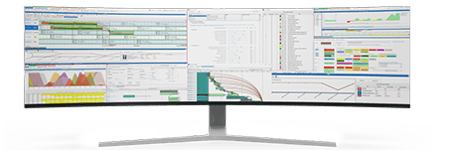
Minimizing Inventory in Industrial Manufacturing
In today’s fiercely competitive industrial manufacturing landscape, managing inventory effectively is more critical than ever. Overstocks tie up valuable working capital and increase holding costs, while stockouts can disrupt production schedules and damage customer relationships. For production planners, achieving the delicate balance between supply and demand requires advanced tools, real-time insights, and seamless integration between manufacturing execution systems (MES) and enterprise resource planning (ERP) platforms.

Why Inventory Optimization Matters
Inventory management is at the heart of operational efficiency in industrial manufacturing. Poorly managed inventory can lead to:
Excessive Carrying Costs: Storage, insurance, depreciation, and obsolescence all contribute to higher overhead when inventory levels are too high.
Production Downtime: Stockouts of critical raw materials can halt production, delaying shipments and eroding customer satisfaction.
Cash Flow Constraints: Tying up capital in unsold inventory limits investment in growth opportunities or technological upgrades.
Waste and Obsolescence: Rapidly changing market demands can render overstocked items obsolete, particularly in industries with high product customization.
For production planners, minimizing inventory while maintaining production efficiency is a challenging yet achievable goal—especially with the help of modern planning tools like PlanetTogether and robust ERP systems such as SAP, Oracle, Microsoft Dynamics, Kinaxis, or Aveva.


The Power of Integration: PlanetTogether and Leading ERP Systems
PlanetTogether’s advanced production scheduling and optimization capabilities are a game-changer for industrial manufacturing facilities. When integrated with leading ERP systems, it creates a powerful ecosystem for inventory optimization. Let’s look into how this integration minimizes inventory while improving overall efficiency.
Real-Time Data Synchronization
Effective inventory management starts with accurate, up-to-date data. Integrating PlanetTogether with ERP systems like SAP or Oracle ensures seamless data exchange across departments. For example:
Demand Forecasting: ERP systems provide detailed sales forecasts, while PlanetTogether uses this data to fine-tune production schedules.
Material Requirements Planning (MRP): Real-time data synchronization ensures that materials are ordered just in time (JIT), reducing excess inventory.
This real-time connectivity eliminates the silos that often plague manufacturing facilities, enabling production planners to make informed decisions quickly.
Enhanced Visibility and Transparency
Integration provides a unified view of inventory levels, production schedules, and supply chain activities. For instance, connecting PlanetTogether with Microsoft Dynamics enables production planners to:
Monitor inventory levels in real time.
Identify bottlenecks in the production process.
Align production schedules with supply chain activities.
This holistic visibility helps production planners identify opportunities to consolidate inventory and reduce waste.
Dynamic Scheduling and Prioritization
One of PlanetTogether’s standout features is its ability to dynamically adjust production schedules based on real-time inputs. When integrated with Kinaxis, a leader in supply chain planning, the system can:
Adjust schedules in response to supply chain disruptions.
Prioritize high-demand products to avoid stockouts.
Reduce production of slow-moving items to prevent overstocking.
Dynamic scheduling enables production planners to respond proactively to changes in demand, minimizing inventory without sacrificing service levels.
Improved Collaboration Across Departments
Integration fosters collaboration between production, procurement, and sales teams. For example, connecting PlanetTogether with Aveva’s industrial software suite enables:
Procurement teams to align purchase orders with production schedules.
Sales teams to provide accurate delivery timelines based on real-time production data.
Production planners to adjust schedules based on procurement and sales inputs.
This level of collaboration ensures that inventory levels remain aligned with actual demand, reducing excess stock and improving operational efficiency.
Predictive Analytics and Demand Planning
Combining PlanetTogether’s scheduling capabilities with Oracle’s advanced analytics tools empowers production planners with predictive insights. This integration allows for:
Accurate demand forecasting based on historical data and market trends.
Early identification of potential stockouts or overstocks.
Data-driven decision-making to optimize inventory levels.
Predictive analytics helps production planners anticipate and respond to market fluctuations, minimizing inventory while maintaining high service levels.
Automating Routine Tasks
Manual inventory management is time-consuming and error-prone. Integration automates routine tasks, such as:
Generating purchase orders for raw materials.
Adjusting production schedules based on inventory levels.
Tracking inventory turnover and identifying slow-moving items.
For example, integrating PlanetTogether with SAP automates these processes, freeing production planners to focus on strategic initiatives.
Measuring Performance with Key Metrics
Integration also facilitates performance tracking using key inventory metrics such as:
Inventory Turnover Ratio: Measures how efficiently inventory is used.
Days of Inventory on Hand (DOH): Indicates how long inventory will last.
Stockout Rate: Tracks the frequency of stockouts.
These metrics, readily available through integrated dashboards, help production planners continuously refine their inventory strategies.
For production planners in industrial manufacturing, minimizing inventory is no longer about guesswork or static spreadsheets. Advanced tools like PlanetTogether, when integrated with ERP systems such as SAP, Oracle, Microsoft Dynamics, Kinaxis, or Aveva, offer the real-time insights, automation, and predictive analytics needed to optimize inventory levels.
By embracing these technologies, production planners can reduce carrying costs, improve production efficiency, and deliver superior customer service. The result is a leaner, more agile manufacturing operation poised for success in today’s dynamic market.
Are you ready to take your manufacturing operations to the next level? Contact us today to learn more about how PlanetTogether can help you achieve your goals and drive success in your industry.